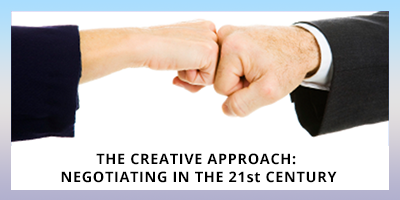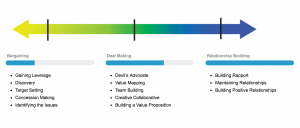GETTING CREATIVE: NEGOTIATING IN THE 21st CENTURY
Participant Questions from Webinar, “GETTING CREATIVE: NEGOTIATING IN THE 21st CENTURY”
by Dr. Bill Sanders, Business Analyst
In last Wednesday’s webinar, Frank and Alexandra looked at the evolving nature of business negotiation. As many business deals, especially for procurement or sales professionals have become more complex, based on repeated transactions and highly-customized solutions, negotiating styles need to change. Old-fashioned power-based negotiating over a single issue, like price, has to give way to a more creative approach. By looking at negotiation modes as spanning a continuum from power-based bargaining on one end to relationship-building and partnering, Frank and Alex showed how negotiating approaches can adapt to fit the situation.
During the Q and A segment at the end of the webinar, there were three very good questions posed and I wanted to give them a little extra attention.
Q1. Can you get into the deal-making mode in every negotiating situation?
The short answer is “no,” but you can try. One of things that makes negotiating difficult is that you can’t completely control the situation because there is another person involved. Like a tennis match, you do have to respond to their actions. If they are taking an aggressive, competitive, power-centered approach, you need to defend your position using the bargaining tools Frank and Alex talked about: leaving room and anchoring, making small concessions over time and asking for something in return. You might get stuck in the bargaining mode. The attempt to move towards deal-making requires that you do not give in quickly but instead work to find a better deal–for both parties. Sometimes just saying the words can get things moving in a more collaborative direction: “There must be a better deal here for both of us; let’s try and find it.”
Q2. What can you do, if other party is bargaining heavily and we are focused on relationship building?
We see this a lot. Relationship building negotiations offer a lot of advantages: they are more pleasant and less contentious, they expand opportunity and foster creativity. More sophisticated negotiators are tempted to always try and use this mode. The problem is that when the other side is focused on aggressive, power-centered, hard bargaining you need to be more focused on defending your interests. We often say, “all negotiations are not the same,” and sizing up the situation and the style of your negotiating counterparty is key to understanding what sorts of tactics and strategies to use. It helps to “put yourself in their shoes” for a little bit to get a better sense of their negotiating style and then formulate your plan using the strategies and tactics best suited to the situation.
Q3. What is the right balance between sharing your needs and protecting your information?
Negotiating tactics and strategies change depending on where you are on the negotiating continuum. In hard-bargaining situations your needs become their source of strength or power which they can use as a lever against you. You need tight control of your information. In deal making you have to share more information about your needs when trying to match your needs with their assets, trading concessions to create a better deal for both parties. In long-term, mutually-beneficial relationships you can be very open or transparent about your needs. The warning is that this only happens when there is a large measure of “trust” in the relationship. Where both sides have demonstrated over a period of time a willingness to look out for the other party, rather than take advantage or engage in opportunism. Our advice is that this has to be more than a “good feeling” about the other side, but based on actual evidence acquired over time. Only when you know, by observation, that your relationship partner has your back, can you be most open with your information.
Thanks to all who participated in this week’s webinar and especially so to the participants submitting these questions. We always appreciate the feedback and we’ll endeavor to share our experiences with you as we continue to present the upcoming webinars in this series. If this blog piece sparks more questions, please feel free to comment below.


